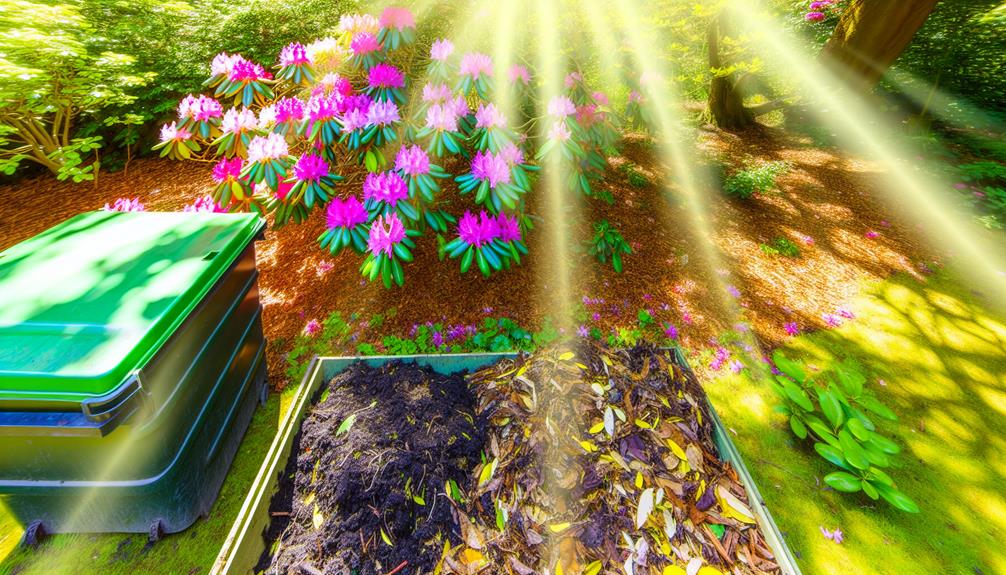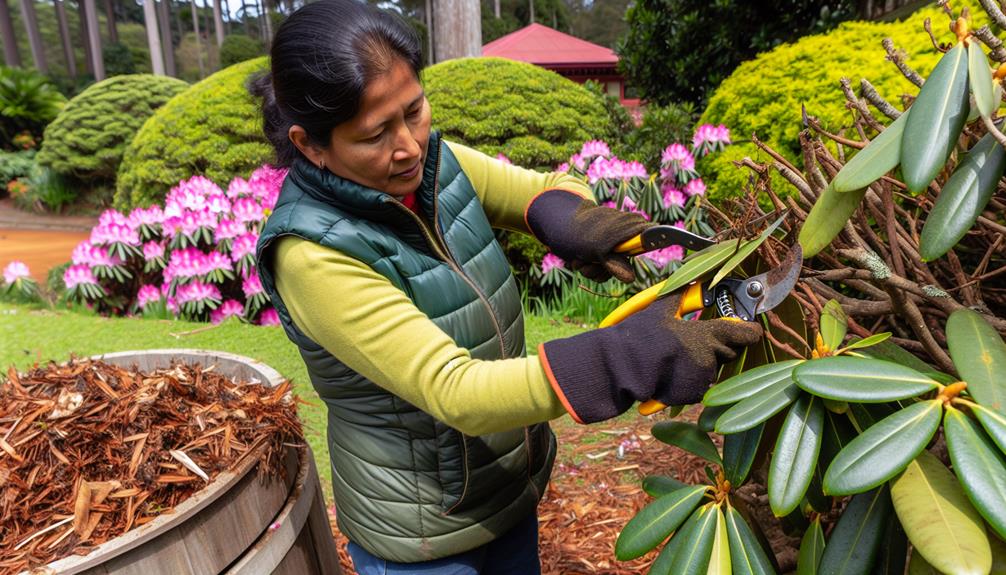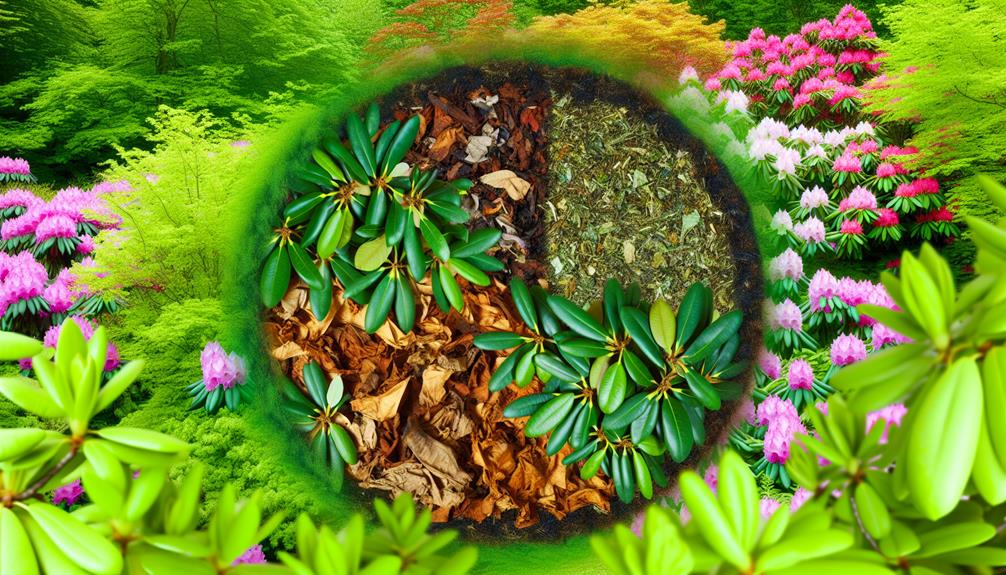

You can compost rhododendron leaves, but you’ll need to prepare them properly due to their thick, waxy texture and grayanotoxins. Start by shredding the leaves to speed up their slow decomposition. Soak the shredded leaves to reduce tannins, then mix them with other compost materials.
Make sure your compost pile has a good balance of green and brown materials, and regularly monitor moisture and temperature levels. Aerate frequently to enhance microbial activity. Following these steps guarantees your compost pile remains healthy and effective. For a deeper understanding of managing compost efficiently, consider further exploration.
Rhododendron leaves are known for their thick, waxy texture, which can make them challenging to compost. This unique leaf structure is designed to protect the plant from harsh weather and pests, but it also means the leaves decompose slowly.
When you’re thinking about adding rhododendron leaves to your compost pile, it’s important to understand these characteristics to manage the composting process effectively.
Another significant factor to take into account is the toxicity concern associated with rhododendron leaves. These leaves contain toxic compounds called grayanotoxins, which can be harmful to both humans and animals if ingested.
While the toxicity is generally reduced during the composting process, it’s important to handle these leaves with care and make sure they’re well-integrated into the compost to avoid any potential risks.
To help break down the tough, waxy leaves more efficiently, you can shred them before adding them to your compost pile. This increases the surface area and promotes faster decomposition.
Additionally, mixing rhododendron leaves with other types of organic matter can help balance the compost and improve overall breakdown. By understanding the unique properties of rhododendron leaves, you can compost them more effectively and safely.
Also Read: Can You Compost Ice Cream?
Composting offers numerous benefits but also comes with a few challenges you should take into account.
First, let’s talk about the pros:
However, there are some cons to take into consideration:
Weigh these pros and cons to decide if composting aligns with your gardening goals.
Also Read: Can You Compost Mail?
To prepare rhododendron leaves for composting, start by shredding them into smaller pieces to speed up the decomposition process. Leaf shredding is essential because it increases the surface area, allowing microbes to break down the material more efficiently. You can use a garden shredder or even a lawnmower to achieve this.

Next, consider the tannin content in rhododendron leaves. Tannins can slow down the composting process and even affect the pH balance of your compost. To help with tannin removal, soak the shredded leaves in water for a few days. This soaking process helps leach out some of the tannins, making the leaves more compost-friendly.
Here’s a quick guide to help you with the preparation:
| Step | Tools Needed | Tips |
|---|---|---|
| Shredding | Garden shredder, lawnmower | Shred into small, manageable pieces |
| Tannin Removal | Large container, water | Soak for a few days to reduce tannins |
| Mixing | Compost bin, pitchfork | Mix with other compost materials |
| Monitoring | Thermometer, moisture meter | Check moisture and temperature levels |
After preparing the rhododendron leaves, you can further speed up decomposition by maintaining the right balance of green and brown materials in your compost pile. This balance is essential for peak compost temperature and microbial activity, which are key factors in breaking down organic matter efficiently.
To make sure your compost pile is thriving, follow these steps:
Also Read: Can You Compost Rust?
Taking into account rhododendron leaves into your compost pile can greatly influence its overall health and efficiency. These leaves are known for their leaf toxicity, which means you need to be cautious. Rhododendron leaves contain compounds that can be harmful to certain plants if not properly composted. To mitigate this, make sure you thoroughly mix them with other compost materials to dilute their effect.

Another aspect to take into account is soil acidity. Rhododendron leaves are acidic, so adding them to your compost can lower the pH level. If your compost becomes too acidic, it can slow down the decomposition process and negatively impact the microbial activity essential for creating rich, fertile compost.
To balance this, add alkaline materials like crushed eggshells or garden lime to your compost mix.
You might wonder if rhododendron leaves, when composted, pose a risk to pets. They contain toxic compounds that could lead to pet poisoning if ingested. Always make sure your furry friends stay safe by avoiding these leaves.
You can use rhododendron leaves as mulch. Mulching benefits include moisture retention and weed suppression. However, be patient as leaf degradation is slow, so make sure they’re shredded to speed up the process for the best results.
When you compost rhododendron leaves, they lower soil pH, making it more acidic. This creates a beneficial soil amendment for acid-loving plants. Join fellow gardeners in enriching your garden with this natural, community-approved method!
When pondering vermiculture safety, it’s essential to guarantee worm health. Rhododendron leaves contain toxins that might harm worms. For a thriving community, it’s best to avoid adding these leaves to your worm bin.
You’ll notice improperly composted rhododendron leaves by the presence of fungal growth and unpleasant odors. If you see mold or smell something off, your compost isn’t breaking down properly, and you’ll need to adjust your process.
You can compost rhododendron leaves, but take some precautions. Shred the leaves to speed up decomposition and mix them with other compost materials for balance.
Be aware that rhododendron leaves are acidic, so monitor your compost pH levels. Adding lime or other alkaline materials can help guarantee neutralization of acidity.
Regular turning of the pile will secure even breakdown. With these steps, rhododendron leaves can be a beneficial addition to your compost.

Don't let aphids, slugs, and caterpillars ruin another plant. Take back control with simple, natural methods that actually work.